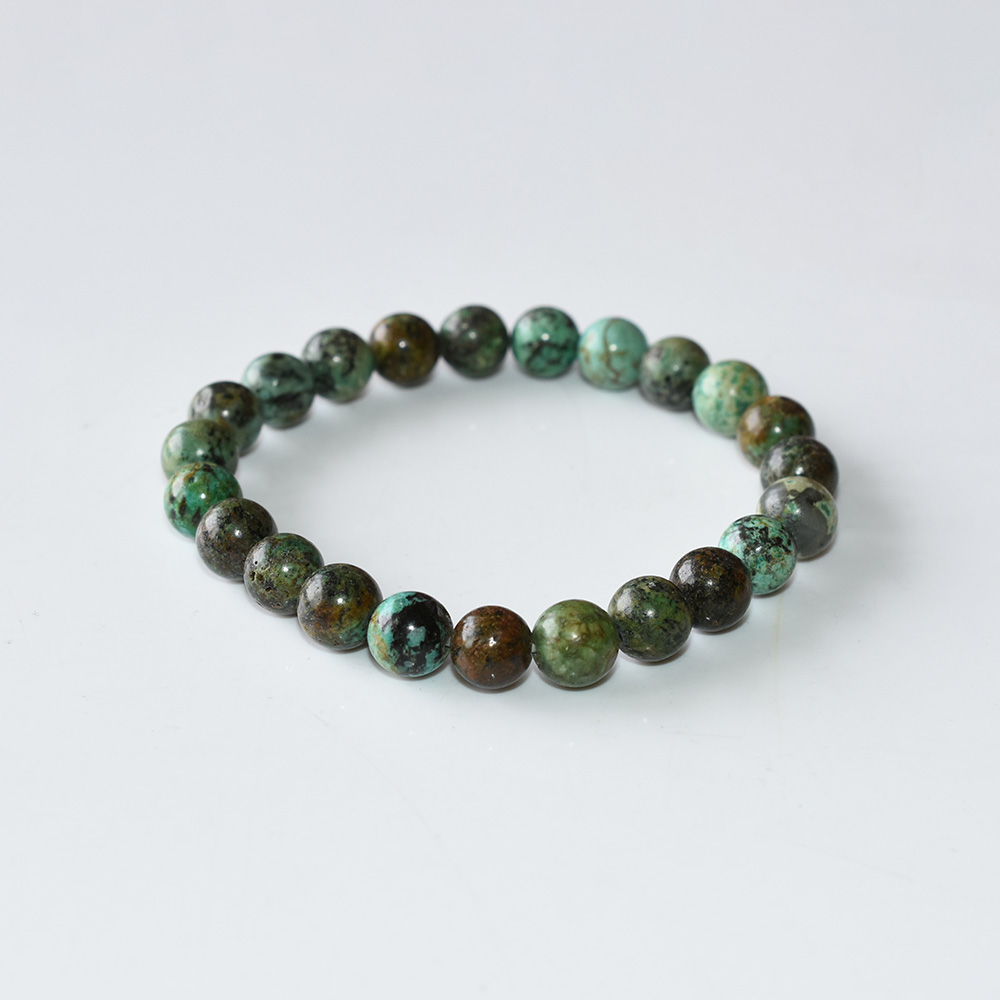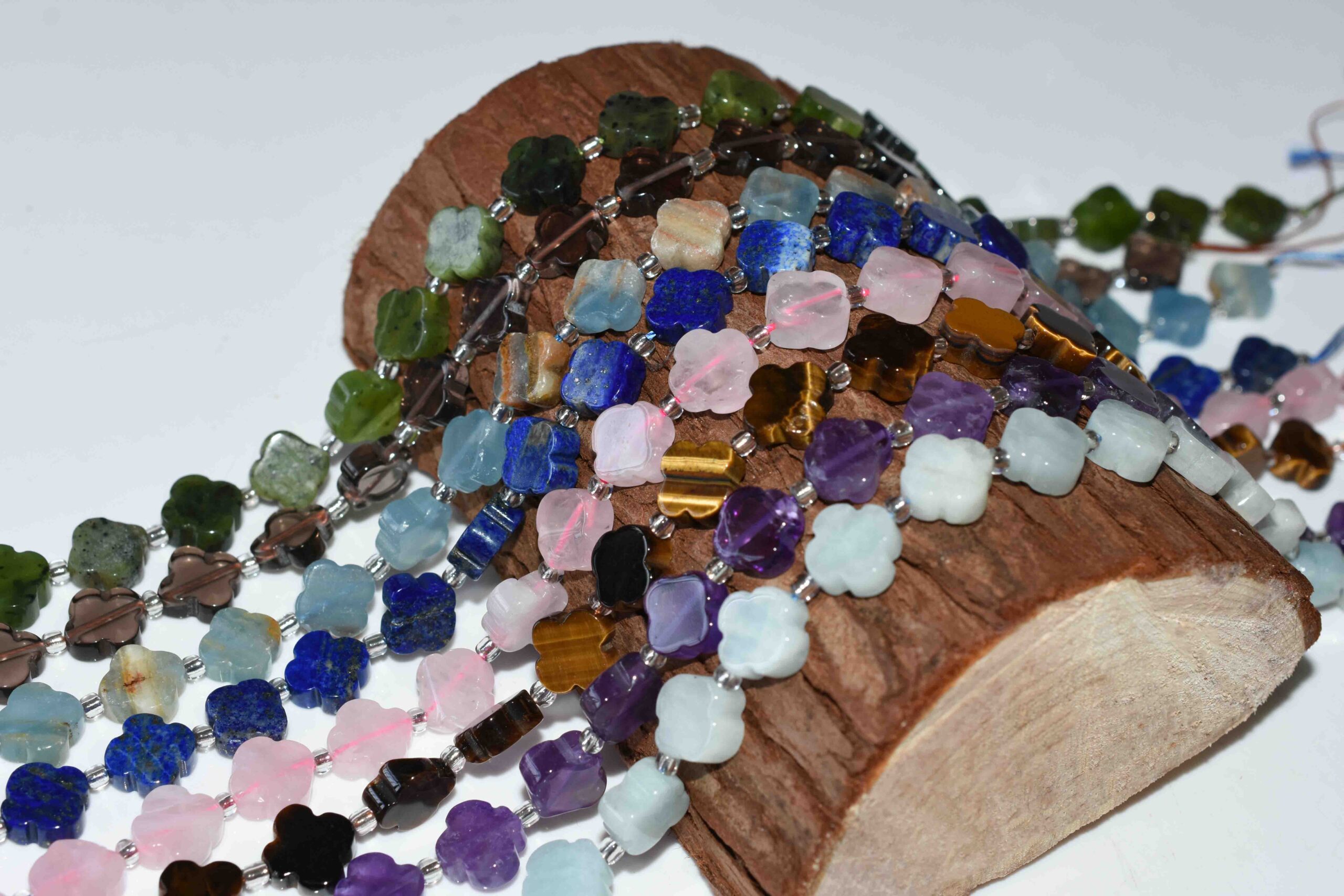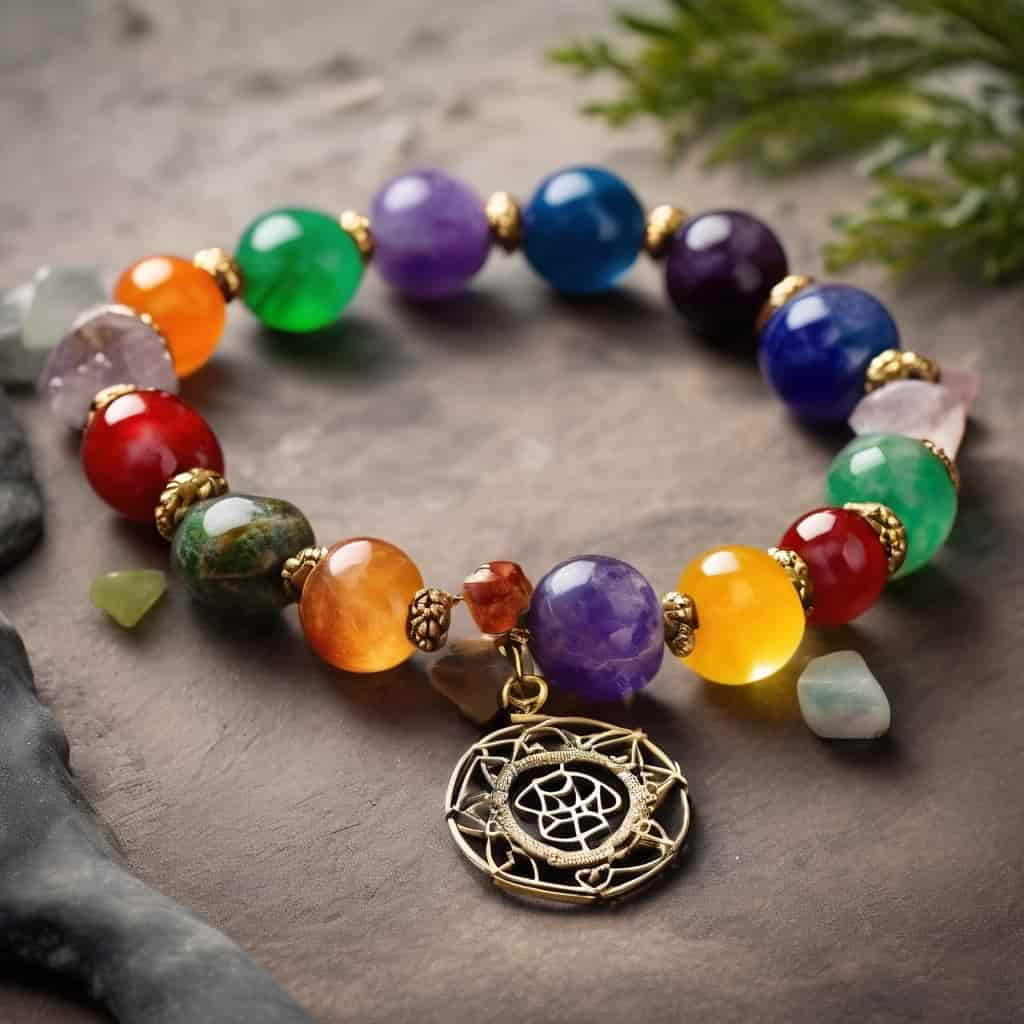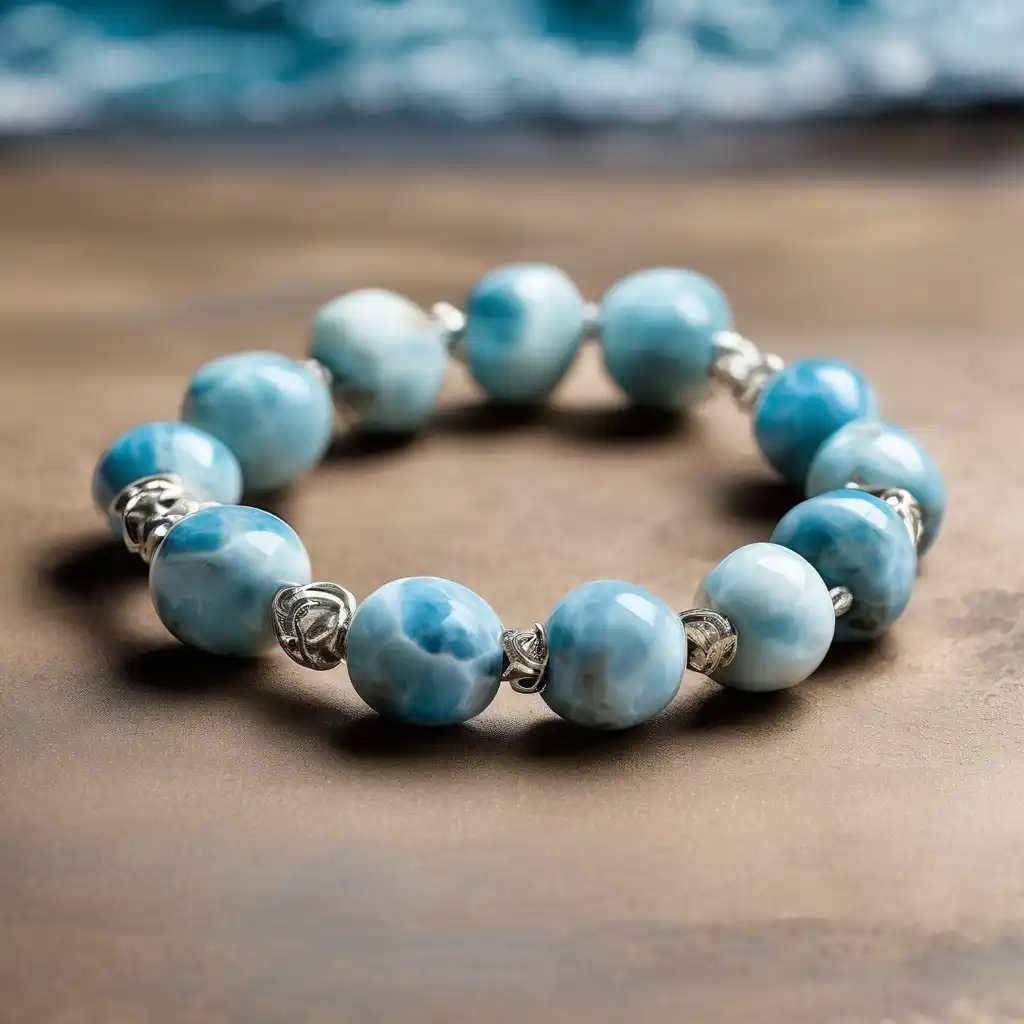African Turquoise Meaning – Properties, Benefits & How to Identify Real vs Fake
Introduction
For centuries, people have been captivated by gemstones because of their natural beauty as well as the energies and symbolism they believed to carry. African turquoise stands out as a stone of metamorphosis and personal development among the many crystals that are trendy at present. Interestingly, new collectors are frequently surprised to learn that African turquoise is actually a type of jasper rather than true turquoise, despite its name. But this difference only serves to highlight unique characteristics and spiritual attraction of African Turquoise Meaning.
Many collectors turn to African Turquoise Meaning to connect with its reputation as the Stone of Evolution. This unique crystal is believed to encourage personal growth, inspire transformation, and restore balance in life. The stone’s earthy blue-green shades, laced with dark matrix veining, give it a charming look that has made it popular in both jewellery and spiritual practices for its grounding and inspiring African Turquoise Meaning. It is gaining popularity as a strong and adaptable crystal for everything from necklaces and bracelets to carvings and meditation devices.
African turquoise is believed to provide emotional strength, open up new possibilities, and bolster one’s sense of purpose in crystal healing. Beyond its aesthetic value, it is valued for giving all aspects of the African Turquoise Meaning in healing practices courage, clarity, and direction.
This guide takes you through African Turquoise in detail—its spiritual symbolism, benefits, authenticity, value, and how to distinguish real from fake. By the end, you’ll understand a treasured crystal in the world of gemstones and metaphysical healing, strengthening the deeper African Turquoise Meaning. Such timeless value continues to shape African Turquoise Meaning. This history helps readers connect with true African Turquoise Meaning.
What is African Turquoise’s Spiritual Meaning?
When people have a discussion about African Turquoise Meaning, the words that often come up are growth, transformation, and wisdom. In the gemstone trade, it is known as African Turquoise Jasper, and this stone is deeply valued for its metaphysical associations, which encourage optimism, resilience, and the ability to embrace life’s inevitable changes. For this reason, many crystal healers and collectors describe it as the “Stone of Evolution.”
Many gemstones are valued just for their beauty, but African turquoise is prized for the meaning inherent in its distinctive patterns. As a reminder of the interconnectedness of all life, its earthy blue-green surface, dotted with dark matrix-like lines, reflects the harmony and chaos in balance. The spiritual properties of the stone extend into mental and emotional well-being, which are important components of African Turquoise Meaning, while its beauty communicates intensity and grounding.
African Turquoise Benefits for Mind and Spirit
Healing / Metaphysical Properties
African turquoise is thought to help stabilize energy and soothe erratic emotions by bringing balance and grounding to the wearer. Its uplifting vibration promotes personal development when pursuing new relationships, career transitions, or life paths. This effect reflects the true African Turquoise Meaning, promoting inner harmony and clarity.
The first time I wore an African Turquoise bracelet, I was in a period of intense busyness. I was feeling quite impatient, constantly thinking about work at night, and feeling quite restless. Wearing the bracelet, perhaps through psychological suggestion or the energy of the stone itself, made me feel calmer and less anxious. This was especially true when I was talking to clients, as it helped me listen more calmly.
Also, I have a European client who bought an African Turquoise bracelet and later emailed me to say that it brought him solace and a sense of security and stability during his time at a new job. While there’s no scientific evidence to support this response, it’s a genuine sentiment from the client, and I agree that this is part of the charm of African Turquoise.
Key Benefits People Often Notice:
- Encourages transformation: Many people say wearing this gives them courage during career or relationship transitions.
- Strengthens wisdom: Some regular customers like to hold it during meditation, saying it helps them get into the flow faster.
- Balances emotions: My personal experience has been that it relieves anxiety and improves emotional stability.
- Promotes acceptance: Many people who buy African Turquoise ultimately say it uses an energy that “gradually helps them accept change.”
Together, these traits reflect the deeper African Turquoise Meaning as a stone of transformation.
African Turquoise’s stabilizing and strengthening properties highlight the essence of African Turquoise Meaning, making it especially valuable for those entering new chapters of life and seeking transformation.
Healing Symbolism and African Turquoise Meaning
African turquoise is believed to offer pathways for calm and compassion during meditation. Its energy is frequently linked to the Chakras of the Third Eye and Throat, which encourage spiritual vision and clear communication. The stone’s vibration also sparks creativity, making it a favourite among writers, artists, and innovators seeking fresh perspectives.
African turquoise ultimately symbolizes stability and advancement. Mainly, African Turquoise Meaning serves as a reminder that actual growth occurs from accepting change while maintaining internal harmony.
Key Spiritual Meanings of African Turquoise
- Transformation & Growth – Encourages strength during transitions.
- Balance & Stability – Grounds emotions, calms the mind.
- Wisdom & Clarity – Offers insight for better decisions.
- Spiritual Awakening – Expands intuition and vision.
- Emotional Healing – Soothes stress and old emotional wounds.
African turquoise is a highly prized stone in metaphysical practice because it continually encourages steady progress and a deeper connection to oneself, whether it is worn in jewellery or used in meditation.
Who Should Wear African Turquoise?
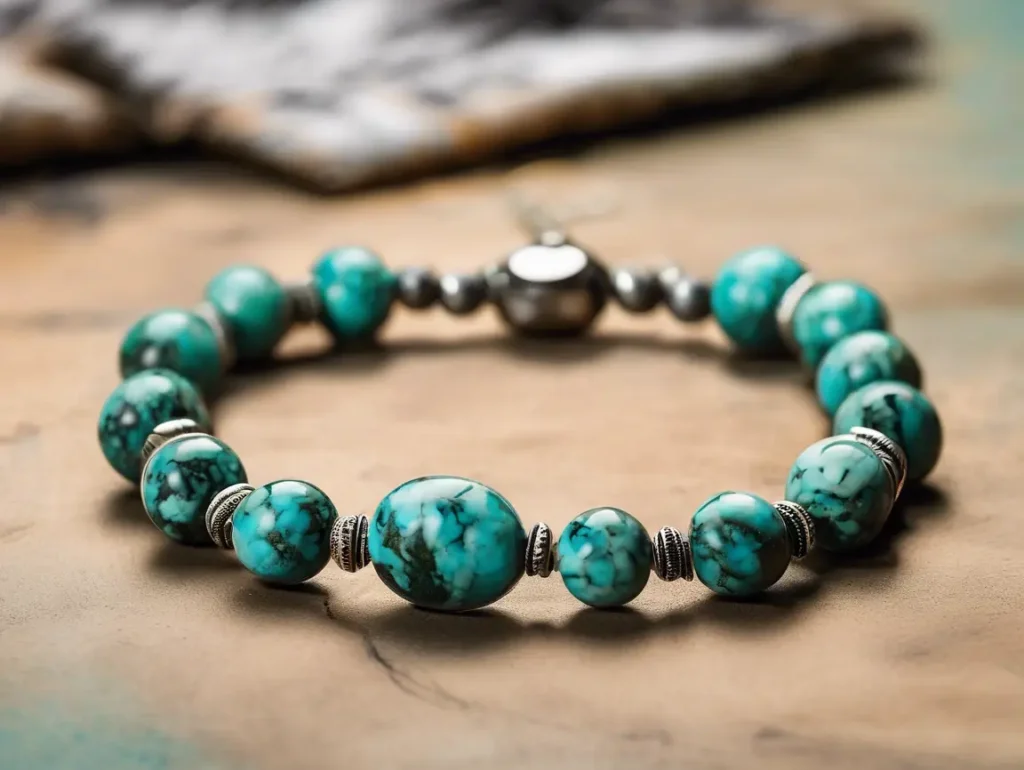
African Turquoise Meaning shows it is a stone that resonates with many people, but it is particularly significant for those who are looking to change, grow, and heal. According to African Turquoise Meaning in astrology and healing, this gemstone is thought to satisfy the soul’s needs at the ideal moment, whether it is prized for its vivid blue-green hue or its spiritual qualities.
In my own sales experience, the most common buyers of African Turquoise bracelets are those going through transitions. Once, a young client in foreign trade told me he was planning to leave his previous employer and start his own business. He was unsure, so he specifically chose African Turquoise. He said the stone, called the Stone of Evolution, perfectly suited his stage of life. Later, when he returned to buy, he smiled and told me that the bracelet had helped him through those difficult months and had given him a sense of peace.
Another time, a middle-aged client bought an African Turquoise bracelet for his wife. He said something that really struck me: “She’s been having a lot of mood swings lately, and I hope this bracelet can help her calm down.” While I can’t guarantee that the stone can truly solve any problem, this thoughtfulness and trust made me rediscover the African Turquoise Meaning.
Ideal for People Experiencing Change
For anyone navigating major life transitions—such as starting a new job, moving to a new city, or entering a fresh relationship—African Turquoise offers stability and reassurance. Its calming energy reduces fear and anxiety, making modifications look easier to manage and empowering.
Spiritual Seekers and Healers
African turquoise, which is closely associated with spiritual awakening and inner clarity, is considered to activate the Third Eye Chakra, which improves insight and intuition. To strengthen their connection with the universe and themselves, energy healers, meditation practitioners, and anyone else on a spiritual path usually wear or carry the stone.
Emotional Healers and Sensitive Souls
African Turquoise provides emotional stability and grounding energy for people who experience mood fluctuations or absorb other people’s feelings. Its vibration maintains the heart open, induces relaxation, reduces tension, and offers moderate protection.
Zodiac Connections
In astrology, African Turquoise Meaning aligns with Sagittarius, Capricorn, Scorpio, and Aquarius. Capricorns often resonate with African Turquoise Meaning for maintaining a balance between emotional stability and ambition. Additionally, the stone is associated with Aquarius and Scorpio, which improve durability, creativity, and transformation and further emphasize African Turquoise Meaning.
Confidence and Self-Discovery
African Turquoise is perfect for anyone who feels stuck or unsure of their path in life. It facilitates reflection, improves confidence, and encourages following one’s feelings, which makes seizing fresh opportunities easier.
Everyday Wear and Jewellery
Wearing African turquoise on a daily basis, whether in the form of mala beads, necklaces, or bracelets, helps keep its transforming and balancing energies close at hand. The stone acts as a continual reminder of development, self-awareness, and progress. African turquoise embodies the full range of African Turquoise Meaning in daily life by promoting focus, adaptability, and confidence, whether you are a professional, student, or spiritual seeker.
Best Lifestyle Matches
- Students: Supports focus, discipline, and learning.
- Entrepreneurs: Encourage adaptability and innovation.
- Healers & Spiritual Seekers: Maintains spiritual connection.
- Everyday Individuals: Offers grounding and calm amidst daily life.
African Turquoise also blends beautifully with other stones, such as Chrysocolla for communication, Onyx for strength, and Lava Stone for grounding, creating harmonious energy combinations that support many aspects of life.
What’s the Difference Between Turquoise and African Turquoise?
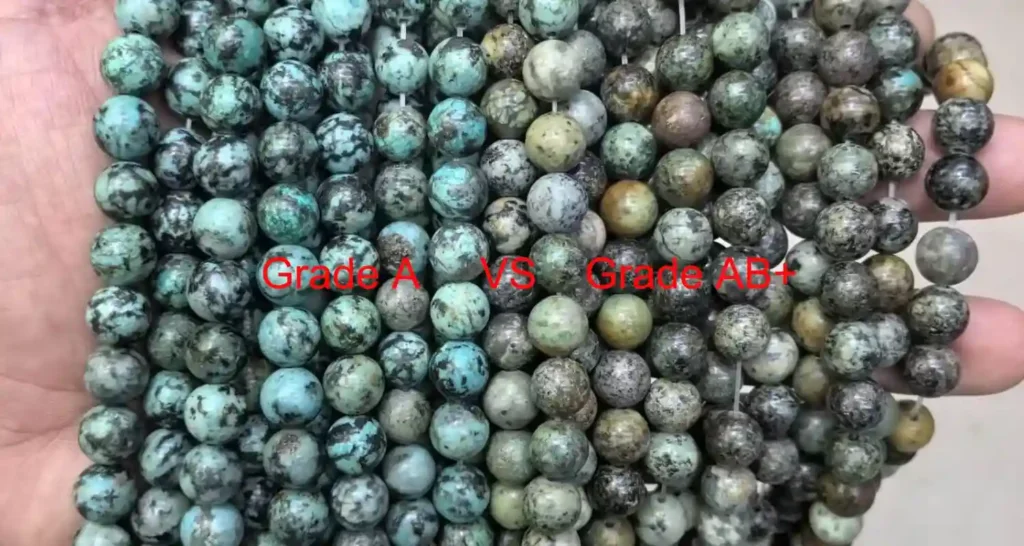
Despite frequently referred to as African turquoise, this stone is actually a kind of jasper that is primarily found in Namibia and South Africa. While the stones are geologically different, its blue-green tones and dark matrix are similar to those of true turquoise. Understanding these distinctions deepens the appreciation of African Turquoise Meaning for collectors, jewellery lovers, and spiritual seekers.
Geological Differences
- Turquoise: A phosphate mineral composed of copper and aluminium, typically found in arid regions like Iran, Tibet, the south-western United States, and Egypt.
- African Turquoise: A jasper variety (a form of chalcedony, which is quartz-based). While it shares similar colouring, it is structurally different from true turquoise.
These differences in composition and structure enhance the understanding and appreciation of African Turquoise Meaning.
Appearance
- Turquoise: Sky-blue to blue-green shades, often with minimal matrix.
- African Turquoise: Teal, aqua, and green tones mixed with brown, black, or golden inclusions.
Durability
- Turquoise: Softer, with a Mohs hardness of 5–6.
- African Turquoise: Harder, 6.5–7 on the Mohs scale.
The practical value of African Turquoise Meaning is highlighted by the fact that African turquoise is harder (6.5–7) and therefore durable for daily wear, carvings, and spiritual practices, whereas true turquoise is softer (Mohs 5–6) and typically stabilized for jewelry.
Market Value
- Turquoise: High-grade stones can be expensive, especially rare varieties like Sleeping Beauty or Persian turquoise.
- African Turquoise: More affordable, though Grade A stones with vivid tones are highly valued. It is less expensive due to its jasper composition, but its durability and spiritual appeal increase its appeal.
Both stones are prized, but African turquoise is especially praised for its metaphysical guidance and symbolism, highlighting the richness of African Turquoise Meaning
Spiritual Distinctions
- Turquoise: Linked to protection, communication, and truth.
- African Turquoise: Known as the Stone of Evolution, symbolizing transformation, growth, and new opportunities.
African Turquoise Benefits vs Turquoise Benefits
- African Turquoise: Encourages adaptability, patience, inner growth, and personal evolution.
- Turquoise: Promotes protection, communication, and good fortune.
Recognizing this difference helps buyers appreciate African Turquoise not only as a durable, beautiful gemstone, but also as a crystal of transformation that embodies a deeper African Turquoise Meaning.
Is African Turquoise Valuable?
The worth of African Turquoise depends on several factors, including grade, colour, pattern, and authenticity. Authenticity plays a huge role in African Turquoise Meaning, since true stones carry durability and healing power. Although it is typically less expensive than real turquoise, certain types are extremely collectible by collectors, jewellers, and enthusiasts due to their unique appearance and the spiritual significance associated with African Turquoise Meaning. This significance adds depth to the overall African Turquoise Meaning.
In my actual business dealings, the African Turquoise I’ve encountered is generally divided into Grade A and AB+. Grade A is purer in color, with a very uniform blue-green color and few impurities, making it particularly beautiful, but naturally more expensive. Grade AB+ often has some black spots and fine yellow streaks on the surface, and the color isn’t quite as pure, but the price is more reasonable, and many customers prefer this natural texture.
One particularly memorable experience was when a customer came to me with two bracelets: one Grade A and AB+. He said he preferred the AB+ because the imperfections made it feel more “natural,” unlike overly perfect gems that lack a certain spirituality. At that time, I realized that the value of a stone, beyond its market price, lies more in the wearer’s experience.
Factors Influencing Value
- Colour: Even, vibrant blue-green stones are more valuable than muted or uneven ones.
- Pattern: Unique matrix lines enhance the stone’s character, though excessive veining may lower its market price.
- Size & Shape: Larger beads, cabochons, or carved pieces fetch higher prices.
- Craftsmanship: Skilful bead cutting and jewellery design add to the overall value.
- Authenticity: Correct identification is crucial; mislabelling is common between African Turquoise, turquoise, and Chrysocolla.
How to Tell if African Turquoise is Real?
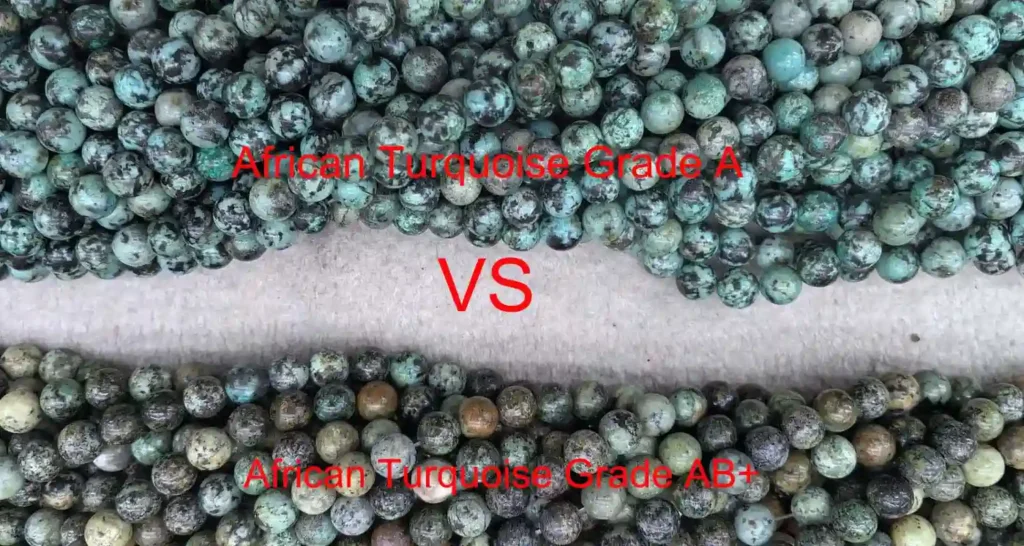
African Turquoise has grown extremely popular in jewellery and Gemstone circles, but with popularity comes imitation. Many stones are misrepresented in the market—some sellers knowingly label substitutes as African Turquoise, while others may unintentionally sell dyed or altered stones. It is crucial for jewellery makers, buyers, and collectors to know how to recognize genuine African turquoise.
From my own experience at the Yiwu market, when I first meet this stone, a seller was selling African Turquoise (A-grade) as Chrysocolla. At the time, I didn’t quite understand and simply sold it to a Germany customer. About few days later, another seller alerted me to the deception. I was deeply upset and quickly apologized to the customer. This incident taught me a lesson: African Turquoise can be easily confused with other stones, and if you’re not careful, you can easily be deceived.
Common Fakes and Imitations
The most popular imitations are marble or howlite that has been dyed. These stones are artificially dyed to resemble the blue-green tones and veining of African Turquoise. At first glance, they appear convincing, but closer examination usually reveals subtle differences.
Identifying Genuine African Turquoise
Material
- Real: A variety of jasper with dark, web-like veining and organic blue-green tones.
- Fake: Usually marble or howlite that was artificially coloured to resemble African turquoise.
Colour and Pattern
- Real: Shows uneven, organic blue-green tones with black, brown, or golden inclusions. The patterns are naturally complex and distinctive.
- Fake: Frequently too bright, uniform, or artificial-looking. Dye may pool in cracks, creating an unnatural look. And it use granite to dyed color, in granite surface have black spot on surface, so dyed color african turquoise surface have black spot too. this is directly way to distinguish real or fake.
Durability
- Real: Mohs hardness of 6.5–7, making it scratch-resistant and ideal for daily wear. Feels dense and cool.
- Fake: Softer (Mohs 3–4), easily scratched with a pin or fingernail. Feels lighter and less substantial.
Surface Test
- Real: Colour remains constant even when rubbed. It won’t fade or rub off.
- Fake: May lose colour with alcohol, acetone, or even water, particularly around porous areas or cracks.
Price
- Real: Generally more expensive, especially for Grade A stones with vivid, consistent blue-green hues.
- Fake: Cheap and mass-produced. If a deal seems too good to be true, it probably is.
Bracelet and Bead Market
Authenticity can be tricky, especially with beaded bracelets. Some vendors mix African turquoise with picture jasper or colored beads to create vibrant designs. While attractive, these pieces aren’t always genuine. Always check descriptions carefully and request verification or certificates to ensure the true African Turquoise Meaning is preserved.
Final Tip
When in doubt, consult a trusted gemologist or buy from reliable vendors. Experienced eyes can quickly distinguish authentic African Turquoise from imitations, so you can be sure that the stone you purchase is real, long-lasting, and carries the true African Turquoise Meaning
What is the Rarest Turquoise Colour?
For centuries, people have been fascinated by turquoise, and certain shades are incredibly valuable and rare. The stone’s origin, colour depth, and the existence or lack of veining, also known as matrix, all affect rarity. Understanding these rare stones also helps collectors appreciate the deeper African Turquoise Meaning in each unique gem.
Rare Colours of True Turquoise
Sky-Blue Turquoise (Sleeping Beauty Turquoise):
This variety, which is mined in Arizona’s Sleeping Beauty mine, is distinguished by its minimal matrix and pure robin s-egg blue colour. It is one of the most valued varieties of turquoise in the world due to its vibrant colour.
Persian Turquoise
Persian turquoise, which comes from Iran, has vivid sky-blue hues and superb clarity. It is extremely sought after by jewellers and collectors due to its limited supply.
Green-Blue Varieties
Higher iron content is frequently the cause of some stones’ tendency toward deep green-blue hues. Because they are less common, these unusual colours have a particular allure for collectors.
African Turquoise and Its Distinct Beauty
African turquoise is actually jasper, in contrast to traditional turquoise. Although it doesn’t reach the same deep blue as Persian turquoise or Sleeping Beauty, its uniqueness, diversity, and grounding energy reflect the spiritual significance of African Turquoise Meaning.
African Turquoise is admired for:
- The mix of blue-green hues with black or golden veining.
- Subtle differences from bead to bead, making each stone unique.
- Durability, which preserves the genuine African turquoise meaning in jewellery and meditation tools, enables it to be shaped into beads, cabochons, spheres, and carvings.
How Do I Know if My Turquoise is High Grade?
A number of factors determine whether your turquoise, or African turquoise, is of high quality: colour, clarity, durability, and overall appearance. Collectors, jewellers, and crystal enthusiasts rely on these qualities to separate premium stones from more commercial options.
High-Grade Traditional Turquoise
For genuine turquoise (the phosphate mineral), high-grade stones usually have:
- Colour: A rich, even sky-blue or deep teal, with no fading.
- Clarity: Minimal or no matrix (the natural veining or patterns). The purest stones, free of inclusions, are often the most valuable, though some collectors are drawn to spider web patterns.
- Durability: Naturally hard stones that haven’t been stabilized or treated are rarer and more prized.
- Source: Certain mines, such as Sleeping Beauty in the USA or Persian turquoise from Iran, are known for producing some of the finest specimens.
High-Grade African Turquoise (Jasper)
African Turquoise is actually jasper; thus, appearance and colour consistency are given more weight in its grading. The trade typically recognizes two main grades:
Grade A:
- Bright, vivid blue-green hues.
- Few visible impurities, resulting in a clean and high-quality appearance.
- IIdeal for premium jewellery, such as polished bracelets, necklaces, and cabochons, ensuring the wearer benefits from the full African Turquoise Meaning
AB+ Grade:
- May contain black spots, faint yellow streaks, or mixed green areas.
- More affordable but still authentic.
- Popular in beadwork and fashion jewellery for its earthy, natural charm.
How to Judge Your Stone’s Grade
Ask yourself:
- Is the colour natural, vibrant, and consistent?
- Are there a few surface flaws or inclusions?
- Is the stone scratch-resistant, long-lasting, and hard?
- Was it correctly labelled (African turquoise vs true turquoise) and purchased from a reliable vendor?
Collectors’ Tip
Beauty is a personal experience. The earthy, varied patterns of AB+ African Turquoise are preferred by some over the perfect appearance of Grade A stones. “High grade” doesn’t always equate to “better”; it depends on your priorities regarding affordability, distinctiveness, or purity.
In essence, high-grade turquoise or African Turquoise combines vibrant colour, durability, and balanced patterns, creating stones that are both visually appealing and spiritually meaningful. Each authentic piece carries energy and symbolism, reinforcing the enduring African Turquoise Meaning in meditation, jewellery, or daily wear.
What is the Prettiest Turquoise?
The “prettiest” turquoise frequently depends on personal preference because beauty is so individualized. Some people are drawn to the bright, uniform sky-blue of classic Sleeping Beauty Turquoise, while others are captivated by the earthy, organic patterns of African Turquoise Jasper. In both cases, understanding the deeper African Turquoise Meaning can enhance appreciation beyond mere aesthetics
Prettiest Traditional Turquoise Varieties
Sleeping Beauty Turquoise (Arizona, USA):
This type is prized in fine jewellery for its robin’s-egg blue colour and minimal matrix, often seen as the epitome of turquoise beauty.
Persian Turquoise (Iran):
Persian turquoise has been prized for centuries due to its vivid sky-blue hues and exceptional clarity.
Tibetan Turquoise:
This type features brown or black matrix patterns and greenish-blue tones, with its web-like designs valued by collectors for both visual appeal and spiritual significance
African Turquoise Beauty
The natural beauty of African turquoise has been praised by jewellery and crystal enthusiasts, despite the fact that it is technically jasper.
Its appeal includes:
- Colour Variations: Teal, aqua, and mossy green tones accented by black or golden veining.
- Unique Patterns: Each stone, bead, or cabochon carries its own one-of-a-kind design.
- Versatility: Can be polished into beads, carved into shapes, or left raw, making it suitable for both spiritual and fashion purposes.
What Rocks Are Mistaken for Turquoise?
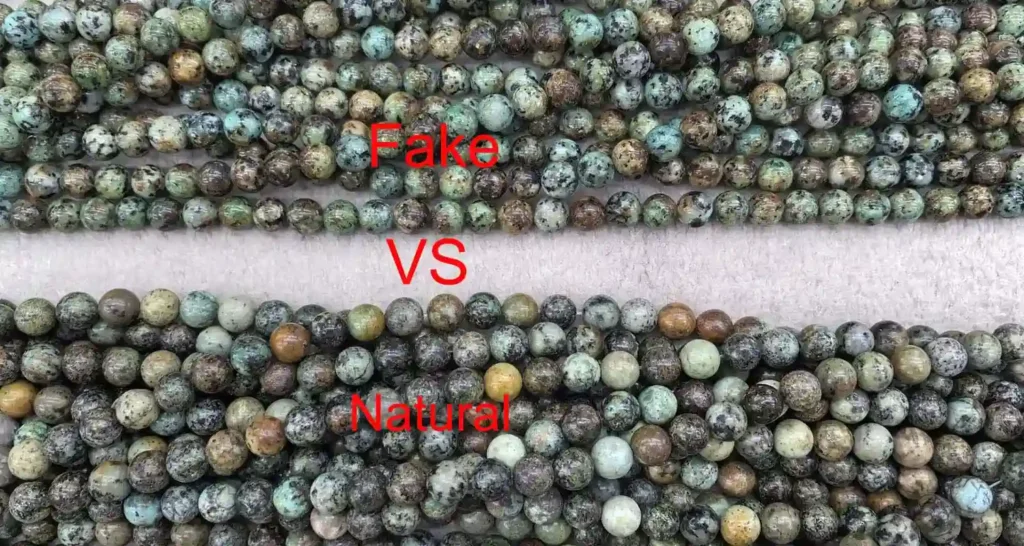
Although turquoise is known for its vivid blue-green hues and organic veining, it is frequently confused with a number of other stones. While some are treated or dyed to look like turquoise, others are real minerals with inherent value. Jewellery makers, buyers, and collectors must learn to recognize each other.
African Turquoise Jasper
African turquoise is sometimes confused with traditional turquoise, but it’s actually a kind of jasper. A popular choice for jewellery and crystal collections, it offers both beauty and meaningful energy. It is valued for its dark veining, teal-to-green tones, durability, spiritual qualities, and distinctive patterns.
Dyed Howlite and Magnesite
Naturally white minerals like howlite and magnesite are frequently dyed blue to resemble turquoise or African turquoise. The colouring of dyed howlite is typically unnatural and uniform, and the dye may rub off or fade over time. Magnesiumite is treated similarly, leading to inexpensive knockoffs.
Chrysocolla
Chrysocolla is a blue-to-green mineral that is based on copper. Although its patterns may resemble those of turquoise or African turquoise, its softer and more delicate nature makes it less appropriate for jewellery worn on a daily basis.
Variscite
Variscite is a rare phosphate mineral that has greenish-blue tones that can make it resemble turquoise or African turquoise. It is smoother than turquoise and tends to lean more toward green.
How to Tell the Difference
- Turquoise: Softer (Mohs 5–6), sky-blue to green, with natural matrix.
- African Turquoise: Harder (Mohs 6.5–7), earthy blue-green tones, dark veining.
- Dyed Howlite/Magnesite: Softer, overly bright, colour may fade.
- Chrysocolla: Soft, vibrant, often mixed with quartz or malachite.
- Variscite: Rare, greener, smooth texture.
Why It Matters
Buyers may become confused by mislabeling, but knowing these distinctions guarantees that you are getting genuine stones. Chrysocolla, variscite, African turquoise, and dyed howlite all have special properties. Understanding them helps you value African turquoise and make informed jewellery or spiritual choices.
FAQ: African Turquoise Meaning & Properties
Q1. Is African Turquoise real turquoise?
A: No. In reality, African turquoise is a kind of jasper. Although it is geologically different, its blue-green colour and matrix patterns are similar to those of turquoise.
Q2. What is the spiritual meaning of African Turquoise?
A: It is referred to as the “Stone of Evolution” and represents development, change, and wisdom, the essence of African Turquoise Meaning. It promotes resilience, optimism, and emotional equilibrium when things in life change.
Q3. Who should wear African Turquoise?
A: It’s perfect for anyone undergoing spiritual development, emotional healing, or transitions. Its energy is beneficial to anyone looking for balance and clarity, but it particularly resonates with Sagittarius, Capricorn, and Scorpio.
Q4. How can I tell if African Turquoise is real?
A: Real African turquoise is a durable stone (Mohs 6.5–7) with dark veining and uneven, organic blue-green tones that hold their colour when rubbed. Fakes, such as marble or dyed howlite, are softer, have more consistent colours, and can fade.
Q5. Can African Turquoise be worn every day?
A: Yes. Because of its durability, it can be worn on a daily basis in necklaces, bracelets, and beaded jewellery. Regular wear is thought to intensify its transformative and grounding effects.
Q6. Which stones pair well with African Turquoise?
A: To increase stability, clarity, and spiritual development, it works well with grounding stones like Black Tourmaline or Lava Stone, stones that improve communication like Chrysocolla, and stones that open the heart like Rose Quartz.
Conclusion
African Turquoise may not be true turquoise, but it has carved out a powerful place of its own in the gemstone world. Known as the Stone of Evolution, this beautiful jasper carries deep spiritual meaning — symbolizing growth, transformation, and inner balance. This is the heart of African Turquoise Meaning. Its unique blue-green tones, veined with earthy patterns, remind us of nature’s harmony and the power of steady change.
Throughout my years in the stone business, African Turquoise has always left a unique impression on me. Unlike true turquoise, which strives for a pure blue, it bears more traces of nature: sometimes black streaks appear within the bluish-green, sometimes yellow spots or brown lines appear. It’s this imperfection that makes it seem more authentic and relevant to life. Many clients who wear bracelets tell me that the stone’s energy is one aspect, but more often, seeing these veins reminds them to accept change and the uncertainties of life.
From its role in meditation and healing practices to its popularity in jewellery such as African Turquoise bracelets, this stone offers benefits that extend beyond appearance. It encourages wisdom, emotional stability, and confidence, making it a valuable companion for anyone navigating life’s transitions.
Whether you are drawn to its grounding beauty, its healing properties, or its practical durability, African Turquoise continues to inspire wearers worldwide. Each stone carries a unique story, just like those who choose to work with it.
- True African turquoise meaning is echoed in this enduring symbolism.
- Transformation remains at the heart of African Turquoise Meaning.
- Many spiritual seekers return to explore African Turquoise Meaning.
- The foundation of African Turquoise Meaning is inner balance.
- African Turquoise Meaning has an unbreakable connection to development and transformation.
- In the end, all these qualities define African Turquoise Meaning.
In the end, the true value of African Turquoise lies not only in its physical appearance but also in the transformation it brings to the heart and soul, which is the essence of African Turquoise Meaning.

